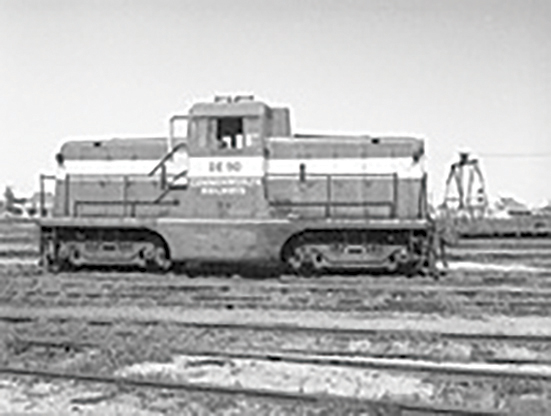Photo of a diesel-electric locomotive courtesy of the Commonwealth Department of Munitions.
By Lyn Forde – President/Research Officer of St Marys & District Historical Society Inc.
DURING 1943 the Commonwealth Department of Munitions imported four diesel-electric locomotives built by the General Electric Company from the USA for use as shunters at St Marys. These were the first diesel-electric locomotives in service in Australia and were obtained under the Lend-Lease system. After WW2 they were taken over by the New South Wales Railways where they were used in the Sydney passenger yards as the 79-class and retaining their original numbers. The NSW railways date from December 1831 when the Australian Agricultural Company officially opened Australia’s first railway located at the intersection of Brown and Church Streets in Newcastle. It was privately owned and operated to service the A Pit coal mine and was a cast-iron fish belly rail on an inclined plane as a gravitational railway. A Fish belly rail was an early form of rail for railways and made from short sections of cast iron between stone block sleepers. The first public Main Western line was built from Sydney to Parramatta Junction in Granville and opened in 1855. Much of the construction of the Main Western, Main Southern and Main North lines were completed under the supervision of John Whitton the Engineer-in-Charge who was considered the Father of the NSW railways serving between 1856 and 1899. The Main Western line was then extended from Granville to Parramatta station and Blacktown in 1860 and Penrith in 1863. In September 1901 at a regular St Marys Council meeting, those present were the Mayor Aldermen G Turner and Aldermen Bennett, Carpenter, Innes, Giles and Millen. A petition signed by some 40 people was read asking that steps be taken in conjunction with Penrith Council to ask the Railway Commissioners to provide an early morning (workmen’s) train to arrive at Redfern in time for people to start work at 8 am because at present the train was of no use to workmen. Consequently people would not reside in the district but if an earlier train was added more people would live here. The Mayor explained that he was waiting a reply from
Mr Thomas Richard Smith as he had written to him asking him to see the Mayor of Penrith in reference to a deputation to the Commissioners on the 17th or 18th of September and he would represent St Marys while Penrith, Kingswood, Mt Druitt and Rooty Hill would also be represented as all these places would all be affected by the train. If they wanted workmen to reside in the district they should offer them an inducement and presently there was nothing in the way of railway conveniences. He thought a workmen’s train would benefit not only the district but the Railway Department as well. Alderman Giles pointed out the importance of urging the addition of the train before 7th October when the new timetable would come into operation, as the commissioners did not care to interfere with a timetable after it had been framed. He moved that the petition be received and Alderman Carpenter seconded. Alderman Bennett thought there was no hope of getting the train as the extra trains that were added lately were now running nearly empty. Alderman Giles mentioned that they put them on at the wrong end of the day. Alderman Bennett said it would be well to consider whether the request was a reasonable one. He himself placed little value on petitions because signatures could be obtained for anything. In glancing at the signatures he said he could hardly find the name of one person who would use the train. The Mayor said he thought the workmen’s train would pay. Alderman Carpenter agreed with Alderman Bennett that a lot of the people who signed the petition would never use the train. The Mayor said that if they signed the petition they could be travelers on the train or they signed it to benefit the people of the district and he would sign it for that purpose. Alderman Giles explained they need not necessarily ask for an extra train if the mail train from Bathurst left a little later and it could serve as a workmen’s train for the people between Penrith and Blacktown. Alderman Millen said that at the recent deputation of tanners he asked Mr Smith to mention the matter of the mail train being used as a workmen’s train but the Commissioners would not listen to it and if we were to get anything it would have to be an extra train. He asked if the Mayor had written to the Penrith Council on the matter. The Mayor said he had only written to Mr Smith our member of the district. Alderman Millen moved that the whole matter of the deputation and petition be left in the Mayor’s hands that was seconded by Alderman Carpenter and the motion was carried. Photo of a diesel-electric locomotive courtesy of the Commonwealth Department of Munitions.
Sources – Wikipedia online, Nepean Times Saturday 14 September 1901






